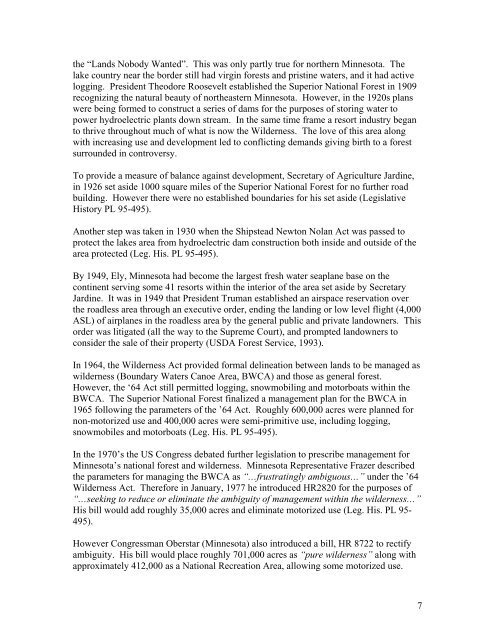Decision Notice and Finding of No Significant Impact South Fowl ...
Decision Notice and Finding of No Significant Impact South Fowl ...
Decision Notice and Finding of No Significant Impact South Fowl ...
Create successful ePaper yourself
Turn your PDF publications into a flip-book with our unique Google optimized e-Paper software.
the “L<strong>and</strong>s <strong>No</strong>body Wanted”. This was only partly true for northern Minnesota. The<br />
lake country near the border still had virgin forests <strong>and</strong> pristine waters, <strong>and</strong> it had active<br />
logging. President Theodore Roosevelt established the Superior National Forest in 1909<br />
recognizing the natural beauty <strong>of</strong> northeastern Minnesota. However, in the 1920s plans<br />
were being formed to construct a series <strong>of</strong> dams for the purposes <strong>of</strong> storing water to<br />
power hydroelectric plants down stream. In the same time frame a resort industry began<br />
to thrive throughout much <strong>of</strong> what is now the Wilderness. The love <strong>of</strong> this area along<br />
with increasing use <strong>and</strong> development led to conflicting dem<strong>and</strong>s giving birth to a forest<br />
surrounded in controversy.<br />
To provide a measure <strong>of</strong> balance against development, Secretary <strong>of</strong> Agriculture Jardine,<br />
in 1926 set aside 1000 square miles <strong>of</strong> the Superior National Forest for no further road<br />
building. However there were no established boundaries for his set aside (Legislative<br />
History PL 95-495).<br />
Another step was taken in 1930 when the Shipstead Newton <strong>No</strong>lan Act was passed to<br />
protect the lakes area from hydroelectric dam construction both inside <strong>and</strong> outside <strong>of</strong> the<br />
area protected (Leg. His. PL 95-495).<br />
By 1949, Ely, Minnesota had become the largest fresh water seaplane base on the<br />
continent serving some 41 resorts within the interior <strong>of</strong> the area set aside by Secretary<br />
Jardine. It was in 1949 that President Truman established an airspace reservation over<br />
the roadless area through an executive order, ending the l<strong>and</strong>ing or low level flight (4,000<br />
ASL) <strong>of</strong> airplanes in the roadless area by the general public <strong>and</strong> private l<strong>and</strong>owners. This<br />
order was litigated (all the way to the Supreme Court), <strong>and</strong> prompted l<strong>and</strong>owners to<br />
consider the sale <strong>of</strong> their property (USDA Forest Service, 1993).<br />
In 1964, the Wilderness Act provided formal delineation between l<strong>and</strong>s to be managed as<br />
wilderness (Boundary Waters Canoe Area, BWCA) <strong>and</strong> those as general forest.<br />
However, the ‘64 Act still permitted logging, snowmobiling <strong>and</strong> motorboats within the<br />
BWCA. The Superior National Forest finalized a management plan for the BWCA in<br />
1965 following the parameters <strong>of</strong> the ’64 Act. Roughly 600,000 acres were planned for<br />
non-motorized use <strong>and</strong> 400,000 acres were semi-primitive use, including logging,<br />
snowmobiles <strong>and</strong> motorboats (Leg. His. PL 95-495).<br />
In the 1970’s the US Congress debated further legislation to prescribe management for<br />
Minnesota’s national forest <strong>and</strong> wilderness. Minnesota Representative Frazer described<br />
the parameters for managing the BWCA as “…frustratingly ambiguous…” under the ’64<br />
Wilderness Act. Therefore in January, 1977 he introduced HR2820 for the purposes <strong>of</strong><br />
“…seeking to reduce or eliminate the ambiguity <strong>of</strong> management within the wilderness…”<br />
His bill would add roughly 35,000 acres <strong>and</strong> eliminate motorized use (Leg. His. PL 95-<br />
495).<br />
However Congressman Oberstar (Minnesota) also introduced a bill, HR 8722 to rectify<br />
ambiguity. His bill would place roughly 701,000 acres as “pure wilderness” along with<br />
approximately 412,000 as a National Recreation Area, allowing some motorized use.<br />
7
















